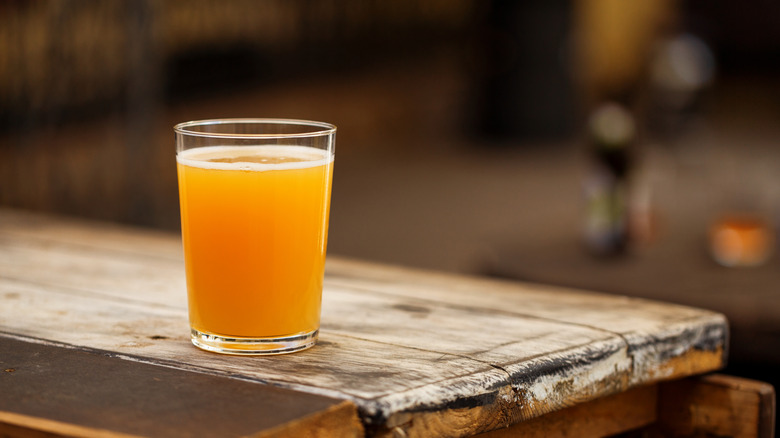Why Hazy IPAs Are Worth Considering, Even If You Hate IPAs
If you've perused a beer menu lately, odds are you've spotted two heavy-hitters going head to head in the craft world: the classic India pale ale (IPA), and its cloudier, juicier twin, the hazy IPA. Both are beloved by hopheads, but if you're the type to recoil at the original version, the hazy variety might be just the ticket to change your mind on craft beer.
Unlike traditional IPAs (not to be confused with standard pale ales), which lean heavily into piney bitterness and sharp citrus peel, hazy IPAs are brewed with aroma and flavor at the forefront. Taking your first sip, you may be conned into thinking you've ordered a tropical fruit punch, with flavors of mango, bright citrus, and pineapple taking center stage, making for an approachable first step into the big wide world of IPA drinking. And if you want to take baby steps, well, first try adding hazy IPA to a citrus cocktail to give it a more complex flavor.
Also, due to a technique called cold-side hopping, where hops are added later in the brewing process, these beers enhance the fruity, floral aroma of the original IPA but seriously dial down the bitterness, making for a mellow taste and easy drinkability. Unlike classic IPAs, which are clear and crisp, hazy IPAs are cloudy by nature as well as by name: They're unfiltered and brewed with grains like oats and wheat that give them a creamy, smooth finish. This silky mouthfeel also makes them more approachable for newbies, as they not only taste delicious but also go down a treat.
A tale of two IPAs
IPAs were born from British colonialism in India, with the origins of the IPA tracing back to the 18th century. As the story goes, English brewers discovered that heavily hopped ales were the only beers robust enough to endure the overseas journey to British colonies, thanks to the preservative power of hops. But while this is probably partly true, the more likely reason it stood out was that it was a far more thirst-quenching drink than dense, dark brown ales, all thanks to its lighter malt base and sharp, hoppy bitterness. Fast forward to the '70s, and IPA was one of the pioneer brews in the beer revolution across the pond, with American brewers turning their hand to reviving beers that had fallen to the wayside of history.
On the other hand, the roots of hazy IPA can be traced back to the early 2010s in New England, where a handful of brewers began to push the boundaries of traditional IPA. Their goal was to create a beer that captured the fruity nature of hops without the bitterness which puts off as many consumers as it attracts. The result? A hazy, golden, aromatic beer as visually appealing as it was tasty.
Dubbed New England IPAs or Northeast IPAs, these beers broke with tradition, with brewers skipping filtration, and leaning on dry-hopping techniques. What started as a regional experiment quickly snowballed into a national movement, with breweries across America creating their own riffs on the hazy, hop-saturated recipe. So, no matter whether you prefer your beer clear and crisp or rich and hazy, each glass you raise carries a story steeped in history.

